Video game characters come in all shapes and sizes. Some are big, some are small. Some are fun, slightly overweight plumbers, and others are cold, angsty teenage warriors. Many of them have not only their own series of games, but spinoffs and huge merchandise lines too. Of course, for every successful character, there are at least a handful that don’t have the chops to make it. Sitting almost squarely in the middle of that range is a plucky little hero who has no arms or legs, but a ton of heart.
No, not Plok. Why would I write an article about Plok?
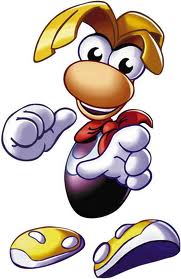 I’m talking about Rayman, of course. That little guy created by Ubisoft way way back in 1995. It’s kinda sad that I can call 1995 “way, way back” without meaning it as a joke. The point here, is that I didn’t play Rayman for years. Hey, can you blame me? I didn’t have a Playstation yet, and I wasn’t big on PC gaming outside SimCity 2000 and Duke Nukem 3D. Given the chance, I probably would have played the game too, since it was an action platformer and I was still pretty hesitant to leave that genre’s warm embrace.
I’m talking about Rayman, of course. That little guy created by Ubisoft way way back in 1995. It’s kinda sad that I can call 1995 “way, way back” without meaning it as a joke. The point here, is that I didn’t play Rayman for years. Hey, can you blame me? I didn’t have a Playstation yet, and I wasn’t big on PC gaming outside SimCity 2000 and Duke Nukem 3D. Given the chance, I probably would have played the game too, since it was an action platformer and I was still pretty hesitant to leave that genre’s warm embrace.
I think the real thing that kept me from Rayman was that none of my friends were interested in his game. Since he wasn’t on a Nintendo platform for four years, Nintendo Power, still my number one video game news source at that point, understandably didn’t have any coverage of the game. The internet was still pretty new in my household around that time too, also it was dial-up. I mostly used it to find breeding charts for Dragon Quest Monsters and to engage in some Yahoo chat. So really, I’m not entirely sure if Rayman was popular at all in his first few years. All I can tell you is that I’d certainly never heard of ‘im.
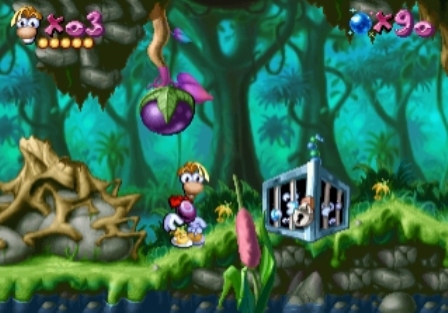
I did, however, have a Nintendo 64 and I did rent Rayman 2: The Great Escape at some point. While I do remember enjoying the game overall, I also have some recollection of it being a little too hard for me maybe? At the very least, I’m sure I didn’t finish it, and at that point it was still fairly common for me to finish most games over the course of a rental. At this point, I think people who weren’t me definitely knew who Rayman was, at the very least in his native France. Big-budget 3D sequels don’t just get thrown around, you know. Bubsy and Punky Skunk didn’t get ’em, so there must have been some requisite level of renown required for the upgrade.
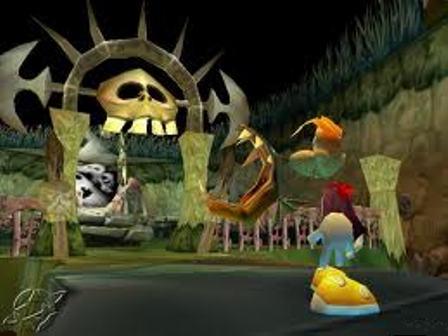
Sometime around this point (and I believe it was 2000), my parents bought us kidlings the PC versions of Earthworm Jim and the original Rayman as an Easter gift. I remember this Easter specifically because it’s also when I procured my Star Wars: Rogue Squadron strategy guide, and that was pretty damn exciting. While I got a decent amount of playtime out of EWJ, my first experience with Rayman was a bittersweet one. On one hand, I’d had a good time with the sequel and was excited to see what the original game was like. The grim reality of it though, is that it was a pretty so-so platformer. I can see it doing well in ’95 with the bright colours and the detailed graphics, but it was the new millennium and cutesy platformers were so out. Also, you know, Rogue Squadron.
I was also learning a little more about the internet and the things one could find within. One of those things I learned about was emulation. If you have no idea what that means, in this context an “emulator” is a computer program that, well, emulates the functions of a video game system. ROMs are the pirated data that make up the games for those systems. When the GameBoy Advance launched, a port of the original Rayman game was one of the first titles available for the handheld. It was a while before I got my GBA (probably a few weeks after launch), but I had a GBA emulator and was trying out ROMs left and right. The Rayman port was one of them, and while I gave it three or four levels, it still wasn’t something that was able to hook me.
Rayman 3: Hoodlum Havoc never found its way into my GameCube, nor did I play the GBA sequel, or the other Rayman spinoff games. Hell, I didn’t even know there was a GBA sequel until now. Apparently there were also racing and fighting spinoffs that I’d never heard of. Good ol’ Wikipedia, fillin’ in those knowledge holes!
Fast-forward a few more years to the launch of the Wii. Rayman Raving Rabbids was one of Wii’s launch titles, and one of the most hyped third-party games to boot. I bought it along with The Legend of Zelda: Twilight Princess on Day One and being as lucky as I am, the disc didn’t work. After a tedious journey back to the store to get a working copy, I started working my way into one of the first of many, many mini-game collections that would find their home on Wii. Despite being one of the first, Rabbids still sticks out as one of the best. Though that isn’t saying much. Generally, if a mini-game collection doesn’t have the words “Rhythm” and “Heaven” in the title, it’s probably mediocre, if not outright bad.
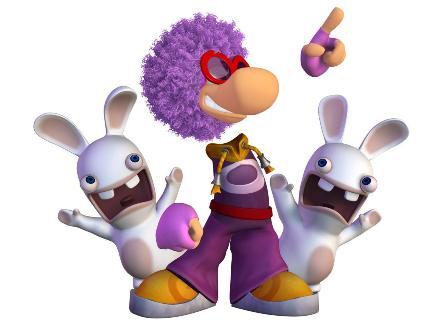
I did have fun with Rabbids though. The handful of rail-shooter levels were tons of fun to play with friends, and easily made up for the weaker games on the disc. The game also had a pretty good sense of humour, making sure that the titular rabbids were always up to something odd or dressed up in funny costumes. It certainly wasn’t a Rayman game though. Sure, Rayman was the main character, and the story was about him escaping captivity from the rabbids, but there was nothing tying it to the previous games outside a handful of characters. Maybe that’s why Ubisoft slowly removed all hints of Rayman from the sequels until it became a wholly independent franchise.
Speaking of sequels, Rayman Raving Rabbids 2 was already much more about the wacky bunny-eqse creatures than Rayman. It was also a fairly disappointing way to spend $50. The shooting levels were still fun, but ultimately it was more of the same, though with nothing significant added to it save another few scoops of wackiness. Sadly, wackiness cannot make a game enjoyable, and I played it maybe thrice before shelving it and eventually selling it. Luckily, that poor experience kept me from buying any of the other sequels, and I’ve saved countless dollars over the years by not purchasing any more of the silly Rabbids games. I haven’t played any of them via friends or piracy either, and truthfully, while I found rabbids charming and funny at first, I feel like they’ve worn out their welcome. At the very least, my life is no less fulfilling now that they’re not a part of it. There has been one Rabbids game every year, and two more are scheduled for the end of this year, which seems a little crazy, but this is the same company that puts out like three Assassin’s Creed games every quarter.
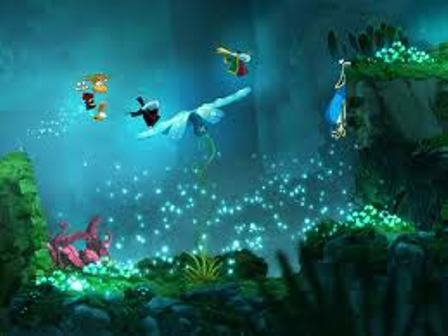
After a few years of slowly falling into obscurity, Rayman finally made a gigantic comeback last year with Rayman Origins. While watching the trailer, the first thing I thought was is this a cartoon for some reason? The second thing I thought was holy crap this is actual game footage. The game is so smooth and beautifully animated that it very literally looks like you’re playing a cartoon. All those cel-shaded games that people have said that about can go suck an egg (coincidentally, I’m sucking on a mini Cadbury Creme Egg as I type this); they’ve got nothing on the sheer beauty of Rayman Origins. But I soon observed that the game was pretty much a Rayman version of New Super Mario Bros Wii, being a 4-player cooperative platformer. While I was impressed by the look of it, playing the Xbox and 3DS demos did nothing to make me want to get the full experience. The controls were a little floatier than Mario, and it seemed a little dull when compared to the riotous fun of Nintendo’s effort.
But then the internet happened. At every video game-related website I visit regularly, Origins received nothing but the highest praise. I still scoffed at the perfectly reasonable $30 price tag, and it wasn’t until my youngest brother started chanting it’s praises that I decided to give it a try in earnest. As it turns out, when I played the demos on my own I was most definitely Doing It Wrong. Rayman Origins is absolutely a blast when played with at least one other person. We didn’t play many levels, but what I saw, I was instantly enamoured with. Of particular note is the super-secret hidden stage: The Land of the Livid Dead. It’s a big, long gauntlet in which you pretty much have to be running full-boar the whole time to survive. It was incredibly difficult, but not unfairly so. The point was to learn from your mistakes and make it a little bit farther each time, not unlike most bullet-hell shooters or roguelikes, only in the form of a very intense platformer. Plus, it had checkpoints, so that was good. Needless to say, I’m pretty eager to play the Wii U sequel Rayman Legends next year.
I should also mention that the enemies in the Land of the Livid Dead are all cranky skeletonized grannies. If that’s not a bullet point for the back of the game case, I don’t know what is.
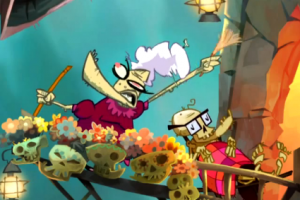
In the meantime though, Ubisoft and Pastagames have released an iOS app based on Rayman Origins called Rayman Jungle Run. In Origins, unlocking The Land of the Livid Dead requires completing several stages that have the same gimmick: run as fast as you can while avoiding the obstacles and collecting kajiggers. Jungle Run is in the same vein of these stages, only it helps you out by making Rayman run automagically.
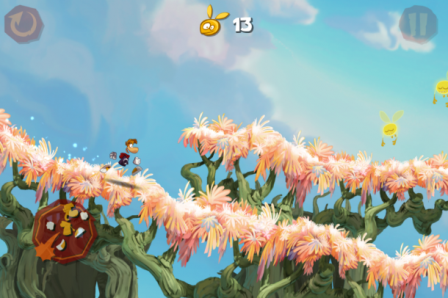
So yeah, it’s a runner game. There are lots of these on the App Store alone, and even more on Steam and other digital game services. What separates Rayman from the rest of the pack? Well, there’s that gorgeous art style. That’s retained and scaled down very well, and Jungle Run looks very close to if not exactly as good as its big brothers. That alone should make it worth the three bucks. Jungle Run also gives you a lot to work with. If you’re a fan of high scores, the game records your best time on each stage, of which there are 40. This is an unusual feature, as most runner games move at a set pace and don’t really allow you to finish with different times; they tend to kill you instead of set you back if you screw up. Rayman can still be killed (or, “bubblized”) by coming into contact with enemies, and there are plenty of bottomless holes to fall down, but most of the time imperfection does not equal immediate failure. It just means you take a little longer to finish the stage.
There is also the question of collecting lums, which have generally been the equivalent of Mario’s gold coins. Here, there are 100 placed in most stages, and collecting them all is a goal, but not a necessity. If you do work your way to a perfect lum count in five out of the nine regular stages in each world, you unlock a Land of the Livid Dead stage. There are four of these, and while they contain no lums themselves, they are much, much harder than the basic stages. They’re obviously not as long as the Livid Dead stage in Origins, but they also lack checkpoints, so making them short was something of a necessity.
You may be thinking “But Ryan, this is still just a stupid runner game with whatcahmacalits to collect” and yeah, it kind of it. But there’s a lot of variety in here. While the jungle environment is one of only two different environments (it is called Jungle Run), there is a fairly wide variety of jungle-themed levels to run through, and different levels take place at different times of the day, which makes the stage aesthetics a little more diverse. The stage design itself is strong too, and it doesn’t end up feeling nearly as repetitive as you might think.
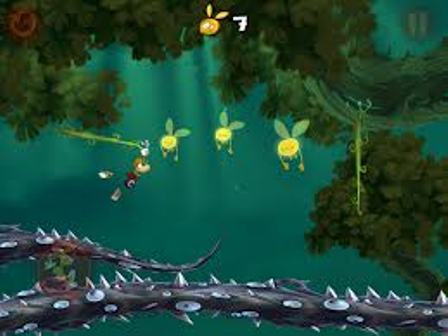
Each new world also introduces a new ability for Rayman, and by the time you hit the fourth world, you’ll be running, jumping, helicopter-hairing, wall-running, and punching just like in Origins. The only difference is that you don’t have to constantly hold right on the control stick and the run button. In that way, Jungle Run is one of the very few -maybe even the only– runner game that feels like a full-fledged platformer squeezed down to work with a touchscreen. The only thing that it really lacks is a feeling of exploration. Since the game is more about getting fast times and collecting all the lums, almost every level has a single path to the goal, with any “alternate routes” just being slightly out of the way so you miss lums. The Land of the Livid Dead stages do feature a little bit in the way of differing paths, but they aren’t nearly fully-realized enough to qualify as a feature. Perhaps the inevitable More Levels Update (2.0, Ubisoft? 2.0?) will put more of a focus on exploration.
All in all, Rayman Jungle Run is the best runner game that I’ve played to this point, and I’ve played a lot of them! We’ll have to see if it maintains that spot when Runner 2: Future Legend of Rhythm Alien hits the Wii U eShop in a few months, but in the here and now it is a solid game and is probably the most compelling game that resides on my iPhone.
With the new, much more interesting direction it’s going in, will Rayman finally be able to break his way into the realm of the big-time video game mascots? Will this limbless wonder finally matter to anyone who isn’t Michel Ancel? Will he finally earn a permanent place in my heart? Only time will tell, but Rayman Legends certainly looks like the kind of game I’d be proud to have in my library, so at the very least, he’s heading in the right direction.
